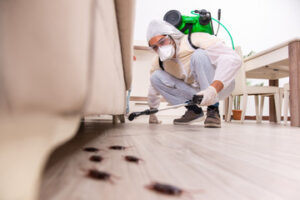Professionals are trained to understand the habits of pests. They will know the best ways to stop infestations before they start. Contact Pest Control Boise for professional assistance.

Preventing pests requires removing sources of food, water and shelter. This may include storing food in sealed containers and removing garbage regularly, fixing leaky pipes and avoiding overwintering sites like roosts.
Prevention is a crucial part of pest control. By removing their sources of food, water and shelter, it is possible to prevent infestations from developing or getting worse. It is recommended that businesses and homes take a number of preventative measures to deter pests, including sealing all accessible food containers, disposing of garbage regularly, fixing any leaky pipes and fitting window and door nets.
Rodents, cockroaches and insects are common pests in many workplaces and homes. They can cause hygiene risks by spreading disease, contaminating food and destroying property. They can also be a threat to human health as they can carry bacteria, viruses, intestinal worms and parasites. Pests can also irritate asthma and other respiratory conditions.
There are a number of methods that can be used to control pests, such as biological control (using natural predators to reduce pest populations) and physical pest controls (removing nests, blocking access points, or using temperature control). Chemical pesticides, which are usually poisonous, are often used in conjunction with other methods and are only available to qualified pest control technicians.
A good pest management program is a team effort, with everyone at the business or home playing their role. It is important to report any building maintenance issues to the management team, and to keep all areas clean to avoid pests from gathering.
It is also a good idea to use insect repellents, which can help to keep pests such as flies and mosquitoes away. Regular maintenance of a garden or outdoor area can also help to deter insects and other pests, as well as keeping all garbage and waste in sealed containers.
Suppression
A key part of pest control involves removing and controlling the populations of pests. This can involve reducing their numbers by blocking access to food sources, changing habitats and using physical methods like trapping or killing them. The removal of pests is often necessary to protect human health and property, as well as to comply with hygiene regulations in places like restaurants or hospitals.
Pests can cause damage by contaminating food, infecting people with diseases or making asthma and allergies worse. They can also eat away at building structures and wiring, which can result in expensive repairs and potential fires. In some cases, they can even cause a lot of stress for homeowners.
There are a number of laws and guidelines that govern pest control. For example, it is illegal to use chemical pesticides without a licence. In addition, pest control professionals should be qualified and have a RSPH Level 2 Award in Pest Management. There are several different ways to prevent pests in homes and businesses, such as putting food in sealed containers and ensuring that garbage is placed in covered bins. Other steps to take include blocking holes in a building, installing rodent-proof screens and placing deterrent sprays where pests are likely to enter.
An integrated pest management (IPM) strategy is a good way to prevent pests from a long-term perspective without the use of harsh chemicals. This type of strategy first monitors and studies pests to determine how tolerance levels are in an environment before selecting the appropriate pest control method. It may include natural methods like biological control, changing cultural practices and introducing resistant plants. Biological controls usually involve the introduction of parasites, predators and pathogens to reduce pest numbers. In some cases, this may be combined with physical pest controls, such as setting traps and applying netting to areas where pests are most active.
Eradication
Pests can cause diseases that can spread to people and animals. They can also contaminate food and damage crops. There are several ways to control pests. These include removing them, changing the environment they live in, and destroying their eggs and larvae. Pesticides are the most common method of controlling pests. They can be used in homes and offices. They can be sprayed or dropped onto the soil. Pesticides can also be poured into cracks and crevices to kill pests hiding there.
There are many different types of pesticides. Some are made from natural substances and others are synthetic. Some are fungicides and herbicides, while others are insecticides. Insecticides are mainly used to kill insects and protect crops from disease-causing pests. They are also a common ingredient in cleaning products such as cockroach and dust mite sprays. They can also be used in household plants to kill weeds.
The word eradicate originally meant to yank something up by its roots, and it is still used metaphorically. It can also mean to wipe out an infection or a race of people. The smallpox and polio eradication programs were successful because they eliminated the microbes that cause the diseases.
Another way to control pests is by introducing predators and parasites to the environment. This can be done by establishing habitats for these organisms or by changing the conditions that favor them. These methods are often more effective than using chemicals. Some are cheaper and faster to implement. They can also be more environmentally friendly. However, the downside is that they can have unforeseen side effects. These side effects can include killing off natural pest antagonists, harming honey bees, pollination, groundwater pollution, and contamination of adjacent crops.
Resistant Plants
Plants are able to protect themselves from pests in many ways. They develop morphological features that interfere with insect movement, feeding and reproduction. Examples include thick cell walls, surface wax, spines and trichomes (hairs). In addition, plants produce an array of chemicals that disrupt insect physiology. Some chemicals are lethal to insects, while others affect insect growth or elicit the release of natural defenses. The development of resistant cultivars can be accomplished through conventional breeding, which involves selecting and incorporating desirable traits into breeding lines over multiple generations, or genetic engineering, in which genes for resistance are artificially introduced into the plant genome.
Plant disease resistance is a great way to reduce labor and maintenance requirements in the garden or nursery. Many horticultural and vegetable crops are available in disease-resistant varieties, including roses (knock out), azalea, boxwood, peonies, hollyhocks, annual and perennial geraniums, chrysanthemums, impatiens, bee balm and more. Many of these varieties are bred for specific diseases, such as black spot on roses or powdery mildew on chrysanthemums.
To overcome pathogen resistance, many of the same mechanisms that trigger plant immunity also subvert it. Some pathogens secrete effector proteins that act as plant transcription factors and suppress immune responses [162]. The P. infestans effector HopD1 prevents the NAC TF ATAF2 from moving from the endoplasmic reticulum to the nucleus, and the Xanthomonas bacterium produces TALE proteins that bind promoter regions of gene families that code for resistance response components.
Chemical pesticides are also effective in controlling some diseases and pests. However, repeated applications of a single pesticide can lead to evolution of resistant pest populations that survive the effects of the herbicide and continue growing unhindered. This is known as the pesticide treadmill, and it can be accelerated by selecting resistant plants that are treated with the same chemical.
Hosts
In biology and medicine, a host is an organism that harbours a parasitic or mutualistic guest (symbiont). Examples include rats hosting the bacteria which cause bubonic plague and bean plants hosting the parasitic nematode fungus.
Pests are organisms that interfere with human activities, either physically or by contaminating food and other products to an extent that they are considered detrimental to wholesomeness and health. They can also damage plants. Pests can be insects, mammals, birds, reptiles, molluscs or microorganisms.
Biological pest control is an ecological process which maintains nuisance organisms below economic damage thresholds through interactions with natural enemies. It has been augmented with artificial intervention to improve its efficiency. Examples of artificial interventions include parasitoids, predators, pathogens and weed-killing chemicals.
Biodiversity is an important factor in pest control processes, but biodiversity effects on pest control are complex and vary between agricultural systems and across landscapes. This chapter explores how biodiversity at a number of levels of biological organization and at distinct spatial scales influences pest control.
The authors find that the framing of particular control strategies impacts their social acceptability, influencing whether or not they are implemented in practice. In general, public acceptance of pest control depends on the extent to which the strategy is seen as being specific and targeted. This finding supports the use of strategies that are framed in such a way that they fit within an ethical framework, which may help guide the development of future control programmes. These findings also suggest that the general public may be more receptive to biological controls such as genetically modified organisms and bacteria, as long as they are clearly explained in terms of their benefit to humans.



